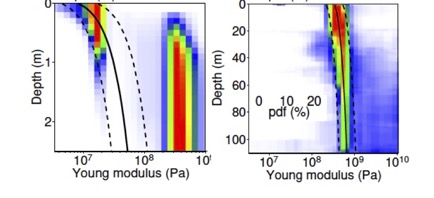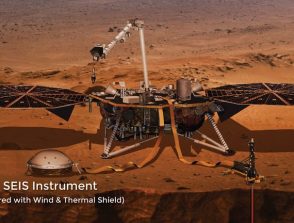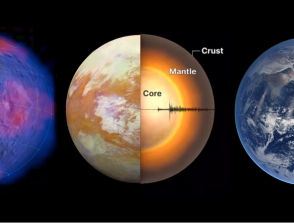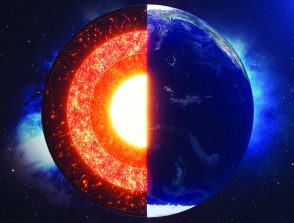Subsurface structure of the Moon and Mars deduced from 10 3D seismic wave propagation simulation and analysis of 11 Apollo and InSight seismic data

Start: 01 October 2019
End: 31 January 2022
Supervisors :
Philippe Lognonné, Taichi Kawamura, Satoshi Tanaka
Related observatories :
InSight Observatory
Related teams :
Planetology and Space Sciences
Related themes :
Earth and Planetary Interiors
Status: Defended
One of the prime goals of planetary seismology is to determine the internal structure of a planet since that gives us critical constraints on its origin and evolution. For example, the global physical structure and chemical composition allow us to estimate the thermal environment at the initial stage of the planetary formation. On the other hand, the superficial and subsurface structures are essential to uncover the subsequent evolution since a planet formed. Thus, it is essential to explore the internal structure in multiple scales in order to discuss the planetary formation and the past geological history from various points of view. This study is devoted to probing the subsurface structures of the Moon and Mars using the Apollo and InSight (Interior Exploration using Seismic Investigations, Geodesy and Heat Transport) seismic data. Unlike terrestrial seismology, seismology on the Moon or Mars relies on limited resource available for each mission (e.g., single station or small network). Furthermore, observations would strongly be affected by environment of each planetary body (e.g., airless body or not, thermal condition).
In the case of the Moon, the particular attention is paid to the seismic scattering which has been regarded as one of the most serious problems in the lunar seismology. Normally, the precise reading of seismic phases (e.g., P, S) is required to determine the internal structure precisely. However, the intense scattering masks the signal arrivals, which results in 1-2 orders of magnitude worse than the case of earthquakes and this leads to a large uncertainty in the resulting structure accordingly. This leaves the detailed lunar internal structure unconstrained and we still struggle to give a critical constraint on its origin and evolution. Therefore, it is important to understand the scattering environment on the Moon and extract information from the available data as much as possible.
Although some previous studies have worked on this subject from the radiative transfer modeling based on the diffusion theory, these estimations still have wide range of uncertainties and still the lunar scattering properties left unconstrained. In the method, the diffusion equation considering the anelastic attenuation effect is used to fit the seismic envelopes. Indeed, it works well for the decay of the seismic coda that strongly reflects the intrinsic attenuation. However, it has a difficulty in fully fitting the envelopes from the first arrival to the energy peak arrival where scattering effects are more dominated. Thus, further investigation is required to fully depict the coda waveform observed on the Moon. In order to evaluate the seismic scattering on the Moon more directly, this study focuses on the 3D seismic wave propagation simulation within a heterogeneous medium. This idea itself was thought long time before, whereas it was technically difficult to perform because it required a vast computation resource. Thanks to the recent development in the high-performance computer (e.g., Earth Simulator, Fugaku), such expensive computations became possible. Making the best of the recent supercomputer enables this study to compute the wave propagation stably up to 2.0 Hz corresponding to the highest computation frequency in this field. This completely covers the observation frequency band of the Apollo long-period (LP) seismometer, making it possible to directly compare the synthetics with the observations at the same frequency band for the first time.
As a result, I succeeded in reproducing the lunar-like seismic waves which are identical with the actual data. That led to the quantitative evaluation of some scattering parameters such as scattering coefficient and scattering attenuation factor which were uncertain or indirectly estimated before. These parameters allowed me to discuss not only the differences in scattering environment between the Earth and the Moon but also how those differences were made. Successful modeling of the lunar coda realized in this study invokes further investigations and refinement in the analysis to better understand the seismic wave propagation on the Moon and to extract more information of the lunar interior. This study has performed the first 3D modeling of the lunar seismic coda and extended the possibility of planetary seismology and also gave us a solid milestone or the progress in future lunar science.
For Mars, we take an advantage of the fact that it is a planet with atmosphere, which was not the case for the Moon. Atmospheric activities will generate seismic signals which enables us to probe shallow subsurface structure on Mars. As demonstrated on the Earth, measuring the ground deformation due to pressure variations will provide us with the ground rigidity, or compliance. Since this method does not require the precise determination of the source location and only requires seismic data with pressure variation measured with co-located pressure sensor, it works very well for the InSight which has only single station. In this study, by applying this idea to Mars, I aim to construct a new subsurface structure model around the InSight landing site. Because the InSight lander is located near the geological dichotomy on Mars (highland in southern hemisphere and lowland in northern hemisphere) and this area is thought to have undergone several geological events such as volcanism and fluvial erosion, the structural information is expected to give us a valuable insight for the past geological activities.
While the initial subsurface structure models show the elastic properties (e.g., Young’s modulus, seismic wave velocity) down to 10-20 m, this research intends to go into as deep as 100 m, thanks to the larger number of events acquired with the updated dataset from InSight. The most novel points of this study are (i) to extend the frequency range for the compliance analysis, and (ii) to take the ambient wind speeds into consideration. The first is related to the depth-resolution of the structure. Due to the lack of high-sampling data at the initial stage of the mission, the previous works had to limit their analyses to the low frequency part (0.5 Hz). Whereas, this study makes use of the high-sampling data which became available in the middle of the mission. Therefore, I have an advantage in the accessible frequency band ( 2.0 Hz), leading to getting the better depth resolution than that of previous studies. Indeed, my analysis succeeded in detecting the 1 m structural discontinuity at the landing site which was unconstrained before. The second point allows us to extend the investigation-depth from 10-20 m to 100 m. In compliance analysis, the ambient wind speed can be regarded as the wavelength under a certain assumption, thereby the higher wind speed results in a longer wavelength and can probe deeper structure. Thanks to this, I was able to constrain the elastic structure deeper than before. My results suggest that the structure around the InSight shows a quite simple structure having 1 m fine regolith layer followed by coarse ejecta layer down to 75 m at least. From both geological observations and analyses of remote sensing data, it is expected to have a low velocity layer related to fluvial sediments around the landing site. Yet, it does not seem that there is such a layer in the top 75 m at least. In order to confirm whether a low velocity layer exists under the landing site area, further investigations need to be done probably in a different way from the compliance analysis because of the loss of sensitivity below 75 m deep. While it might be difficult to provide a critical constraint in the Martian history from my results, it is believed that the proposed model in this study would give us a milestone for the future subsurface explorations on Mars.
To summarize, this study explored the subsurface structure of the Moon and Mars from two independent approaches depending on the respective observation conditions. As a result, each approach worked well and led to a significant progress for understandings of scattering structure at the Apollo 12 landing site on the Moon and elastic properties at the InSight landing site on Mars. In particular, since few studies have performed 3D simulations implementing the intense scattering, the successful demonstration in this study opened a new window to exploring the seismic signals of extraterrestrial planets. Also, as the improved compliance analysis on Mars can be applied to other planets holding atmospheres, the technique would contribute to further developing the comparative planetology in terms of subsurface structure.







